Jan 25, 2018
What causes an Ice Pressure Ridge?
An ice pressure ridge results from a change in temperature which causes the ice to crack.
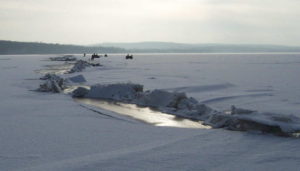
Ice Pressure Ridge – Door County
This forms a floating sheet of ice. When an area of open water is present the sheet of ice is able to move freely.
Think of an ice cube when you first put it into a glass of water. When exposed to the warmer water the ice cracks at the weakest part.
Where Does the Pressure Ridge Start?
A pressure ridge usually starts a few hundred feet off the shoreline in what would be 2-3′ of water in the summer. Up to this point, the ice is anchored to the bottom of the lake. The ice near the shore remains very stable and does not move from the shoreline.
Water begins at this point under the ice. The water gets deeper as you go out. Much like an ice cube, the ice will “crack” when exposed to pressure from winds or warmer temperatures.
If you have ever been on or near the ice in winter, you have heard the ice “crack”. The wind is generally blowing at these times or the ice may have been exposed to warmer temperatures. The ice builds up pressure at the open-water mark. The ice separates and “cracks”. This sound can travel for miles.
The pressure ridge may form anywhere there is thin or weak ice.
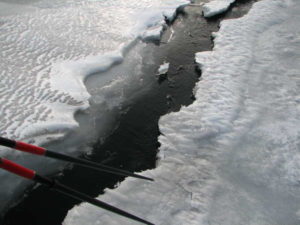
Ice crack before forming an ice pressure ridge – Door County
How does the Ice Pressure Ridge form?
With the ice near the shore securely anchored to the shoreline and the bottom, the floating ice on the outer side of the crack moves away from or along the shore with the wind. If the direction of the winds changes it moves
With the ice at the shore anchored to the shoreline, the floating ice on the outer side of the crack moves away from or along the shore with the wind. When the direction of the winds changes it moves back to the joint or along the joint again.
When the floating ice hits the stationary ice on the shore, pressure builds up and crushes the edges into pieces called “rubble”.
Some of the “rubble” sinks to the bottom due to weak ice under the top layer. This rubble forms the “keel” of an ice pressure ridge. The loose “rubble” continues to accumulate under the main shelf of ice until it hits the lake bottom.
When the “rubble” hits the bottom there’s no place for the “rubble” to go – except vertically. Now the accumulating rubble forms the “sail” on the upper part of the pressure ridge. The “sail” can be anywhere from inches high to 50 feet high depending on the winds and the strength or weakness of the ice.
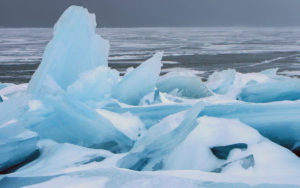
Ice Pressure Ridge
When the “rubble” hits the bottom there’s no place for additional “rubble” to go – except vertically. Now the accumulating rubble forms the “sail” portion or upper part of the ice pressure ridge. The “sail” can be anywhere from inches high to 40 feet high depending on the winds and the strength or weakness of the ice.
How fast does the Pressure Ridge form?
A pressure ridge usually forms rapidly when the winds are blowing strong and steady. You need to be especially careful when approaching the pressure ridge because you don’t know how much solid ice remains.
Since the “rubble” below has been exposed to non-freezing temperatures, it starts to melt away. This results in a weak and fluctuating joint at the surface. The area around the ice ridge can be very dangerous.
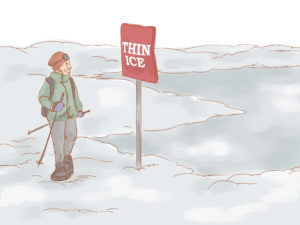
Warning – Thin Ice
Are there other signs of weak ice?
Slow melting ice will result in dark areas which means the water on top and below the ice is melting the ice away. Never go on this type of ice as it is very weak. Be careful around pressure ridges, they indicate the presence of weak ice.
Ever wondered what causes ice shoves?
See our next article on January 30th for an explanation.
Reminder
Pier & Waterfront Solutions specializes in ShoreMaster docks, lifts, and accessories both residential and commercial. We service the rest.
PWS is located in the center of Door County at 7325 St Hwy 57. Located 1 mile North of County MM (Hwy 42) and South of Sturgeon Bay at the intersection of Idlewild Road. Our staff looks forward to assisting you.
Want us to address a dock or boat lift topic for you? Feel free to give us a call.
Call Jerry at 920-493-4404 or Email Jerry@wisconsinpws.com for more information.
Nov 28, 2017
Jet Ski Lift Platform
A Jet Ski Lift platform is the latest development of Pier & Waterfront Solutions. These stainless steel loading platforms are made exclusively for the ShoreMaster SM 1064 and SM 1264 Jet Ski Lifts by PWS.
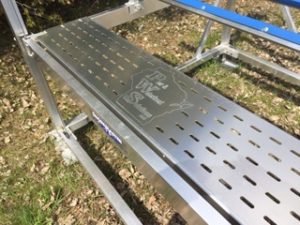
Jet Ski Lift Platform
The jet ski Lift platform kit consists of a stainless steel, perforated platform that mounts securely to the lift rack.
- No need to drill holes and risk damage to the cables inside.
- The platform never rots.
- Simple to install – one 9/16” wrench is all you need.
- Stainless steel platforms provide a stable loading or working platform.
- The walk platform allows easy access to both sides of the Jet Ski – in or out of the water.
Additional benefits
- It allows you to put a cover on your Jet Ski while high and dry.
- Why scramble over your jet ski to put a cover on?
- No more getting tossed around by waves while trying to work.
- No more trying to stand on the lift rack and risk falling or injury.
Imagine being able to service your jet ski without having to stand in the water. Now you have a loading platform to set your equipment on when working on the engine or re-fueling your unit. You can do all kinds of work and stay dry.
How About another Great Idea?
Also offered by Pier & Waterfront Solutions – a Jet Ski winch extension post kit.
The extension post kit allows you to move the winch higher on your ShoreMaster lift post. Now you have better access to the wheel from the dock – even if the dock is above the lift wheel. No need to lie on the dock in order to reach the wheel.
Reminder
Pier & Waterfront Solutions specializes in ShoreMaster docks, lifts and accessories both residential and commercial. We service the rest.
PWS is located in the center of Door County at 7325 St Hwy 57. It is located 1 mile North of County MM (Hwy 42) and South of Sturgeon Bay at the intersection of Idlewild Road.
See a complete list of articles at “News” on our website.
Want us to address a dock or boat lift topic for you? Feel free to give us a call. We believe that an informed consumer makes better decisions.
Call Jerry at 920-493-4404 or Email Jerry@wisconsinpws.com for more information.
Nov 21, 2017
Boat Lift Canopy Maintenance
Boat lift canopy Care will provide you with years of service, if properly used and maintained.
Proper maintenance is important in the Fall
Boat Lift Canopy care is an important step to extending the life of your canopy. As the air gets cooler and the days shorter, the leaves begin to turn colors. You know what’s ahead. You can hope for more sunny, warm days but we know that nature is in total control.

Fall Foliage
We also know there are some things we need to do to maintain our docks, boat lifts and accessories. It’s more than simply moving the equipment up on the shore. Protecting the equipment from the ice is just the beginning of what should be done.
Note – It should be pointed out that while PWS does remove and store your boat canopy in your designated spot as part of our removal service, canopy cleaning is not part of the service due to the length of time it takes to clean and thoroughly dry the cover as explained below. The process can take a full day to be done properly. After cleaning the canopy it must be thoroughly dried before storage.
What steps do I need to follow with a Boat Lift Canopy?
Follow these simple rules to get the maximum life from your canopy.
1. Always avoid allowing water to puddle on the canopy for extended periods of time during the season. Water, excessive bird droppings and dirt cause discoloration.
2. It’s important to keep the canopy free of battery acid and tree sap. These may corrode and eat holes in the canopy.
3. Always fold and store the canopy ONLY when completely dry. Wet or damp vinyl will discolor and form mold/mildew if stored in that condition. Storage in a warm, dry location will extend the life of your canopy.
4. If stored in a bag make sure it is breathable. Do not use a plastic bag. Moisture will be trapped inside and mold or rotting will occur.
5. DO NOT use chemicals or abrasives to clean a boat lift canopy. This could damage the vinyl. Use a soft cloth, mild dish soap (like Ivory) and water for best results.
6. Of course, Do Not get too aggressive when cleaning bird droppings from the vinyl cover. You may wear the protective finish off in that area or tear the vinyl.
7. If weather is threatening, keep the boat on the lift. Without the weight of the boat to hold it down the lift could be flipped over by the canopy.
8. The boat lift canopy must be removed when taking the boat lift out of the water for any reason. Failure to do so could result in wind damage to the canopy, boat lift and surrounding equipment.
9. Additionally make sure the boat lift canopy is completely dry before storing it. This will prevent mold and mildew from ruining the canopy. Those autumn leaves are beautiful but if left wrapped in your canopy they will permanently discolor your canopy cover.
CAUTION: A Vinyl canopy is removed by detaching hooks. Stretching and removing bungee cords requires strength and proper balance. DO NOT let release the bungee cord when under tension. An eye injury or other bodily injury could occur. ALWAYS wear safety glasses and the proper protective clothing.
Boat Canopy Care
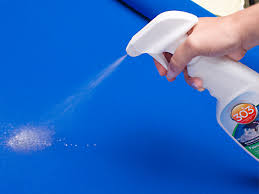
Boat Lift Canopy cleaning
The cleaning and proper storage of your boat canopy requires some basic supplies and steps to ensure the longevity of your cover.
The first step is to ensure that any product that you use is safe for your canopy material. If you must use a chemical to clean your canopy, be sure it does not contain any ingredients that will stain, corrode, or otherwise damage the material.
The next step is to remove the canopy from the lift. Once removed, spread the canopy out on a flat clean surface – grass is fine. You need to avoid damp or freshly mowed areas as this may increase the work you end up doing. (Remember to remove any cut grass, etc from the bottom of the canopy before folding for storage
PREFERRED METHOD; Use a gentle dish detergent and warm, soapy water and a soft bristled brush to gently clean the surface. Rinse well and allow the boat canopy to dry thoroughly.
Boat Lift Canopy Storage
After thoughtfully drying it, store the boat canopy by carefully folding the canopy in on itself several times until it resembles a strip 18”-24” wide and then roll the canopy into a roll that is manageable. Many canopies will come with their own storage bag but if yours did not, take care not to store the canopy in a plastic or otherwise un-breathable material. Remember – It MUST breathe through the winter.
DO NOT roll the canopy cover so tight that it can not breathe and DO NOT put a sharp crease in the material. The canopy should be allowed to “rest” in a protective bag or box that allows for proper air movement. If the bag does not allow the canopy to breathe, moisture could accumulate and promote molds and mildew in the off season, ultimately making your canopy’s life-span shorter.
Do not store on the floor where moisture can accumulate under the bag or box.
You should avoid binding the boat canopy for storage and never use duct tape to keep the canopy bundle together as the glues used are difficult to remove. Binding the canopy for long periods could promote intense creasing that may eventually lead to splitting of the canvas.
The stitching and seams that hold your canopy together should be kept as clean and dry as possible to avoid the failure of these areas from exposure to moisture, mold and dry-rot as the years roll by.
Prevent small animals (squirrels and mice) from getting into the rolled material. They can cause stains and premature product failure if allowed to set up housekeeping in your cover.
What about the Canopy Hardware?
Bungees, springs, cords, straps, etc., should be stored in a SEPARATE bag and kept with the canopy to avoid misplacement of the hardware and unintended damage to the canopy by these items. If rolled into the fabric layers for storage, moving the bundle can wear through the fabric and accidentally punch holes in it.
Remember
Pier & Waterfront Solutions (PWS) specializes in all ShoreMaster docks, lifts and accessories.
Located in the center of Door County at 7325 St Hwy 57, just south of Sturgeon Bay at the intersection of Idlewild Road. Our staff looks forward to serving all of your waterfront needs year round.
Equally important, if you found this article helpful – Go to “NEWS” on any page of our website for a complete list of articles. These articles are meant to keep you informed on the latest product information and maintenance issues. Check out our “older entries” also.
The wide variety of articles on dock and boat lifts issues will answer many of your questions. PWS believes that an informed consumer makes better decisions.
Call Jerry at 920-493-4404 or Email Jerry@wisconsinpws.com for more information.
Nov 14, 2017
Boat Lift Motor Care for a Wheel Driven Boat Lift
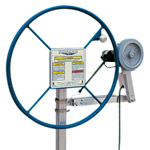
ShoreMaster Lift Mate
Boat Lift motor care for a rubber, wheel-driven motor, consists of a few simple steps for storage.
In general, it’s important to understand how the drive works.
How does a Boat Lift Motor work?
The Shore Master “Lift Mate” motor shown here, applies pressure to the outside of the large hand wheel. The tension is applied by the use of a bungee cord. A flip of the motor switch is all it takes to raise or lower the boat without any effort. These are generally powered by a solar arrangement. AC driven units are also available. You never have to turn the wheel by hand again.
However, this simple boat lift motor setup requires some common sense care for the winter..
For winter storage you have a choice:
First, you can release the bungee cord and remove the motor assembly arm completely by removing the large pivot arm bolt on the mounting assembly. Then, store the motor in a building for the winter.
or
For a Second choice – relieve the tension on the bungee cord. Then, leave the motor in place. This will prevent a a flat spot from forming on the rubber wheel over the winter. If you use this step – Do not rotate the motor down.
NOTE: The bungee cord has a lot of tension on it. For this reason – handle it with caution. Eye protection is recommended. The cord can slip out of your hand, causing the hook on the end to hit your hand, arm or eye. Grip it firmly. The same is true when re-attaching the bungee cord and hook in the Spring.
Remember, if you choose option 2, release the tension on the bungee cord BUT DO NOT rotate the motor arm down. Leave it in the operating position for the winter. Rotating the motor down will allow moisture to seep into the motor casing. This will cause a build up of water inside the motor which will prematurely damage or short out the motor when power is re-applied.
Similarly, DO NOT wrap the lift motor in a plastic bag for the winter. Moisture from condensation or rain and melting snow has been known to fill the bag with water with disastrous results.
An alternative to the Wheel-Driven Boat Lift Motor
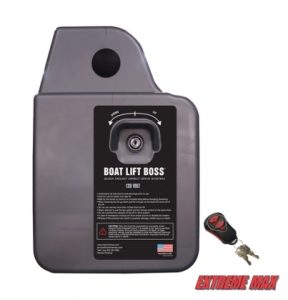
Lift Boss
An better alternative to a wheel driven motor drive is the Lift Boss motor. With this type of motor the large wheel is removed completely. This boat lift motor is generally driven by solar energy with an A.C. model available. The motor can be left exposed to the elements year round. There is no bungee cord to remove and no slipping when the wheel is wet from rain or the morning dew.
The housing allows moisture to escape without fear of damage to the motor.
For more information about boat lift motors see also https://wisconsinpws.com/lift-boss-motor-hard-raise-boat/
Remember
Pier & Waterfront Solutions (PWS) specializes in all ShoreMaster docks, lifts and accessories.
Located in the center of Door County at 7325 St Hwy 57, just south of Sturgeon Bay at the intersection of Idlewild Road. Our staff looks forward to serving all of your waterfront needs year round.
Equally important, if you found this article helpful – Go to “NEWS” on any page of our website for a complete list of articles. These articles are meant to keep you informed on the latest product information and maintenance issues. Check out our “older entries” also.
The wide variety of articles on dock and boat lifts issues will answer many of your questions. PWS believes that an informed consumer makes better decisions.
Call Jerry at 920-493-4404 or Email Jerry@wisconsinpws.com for more information.
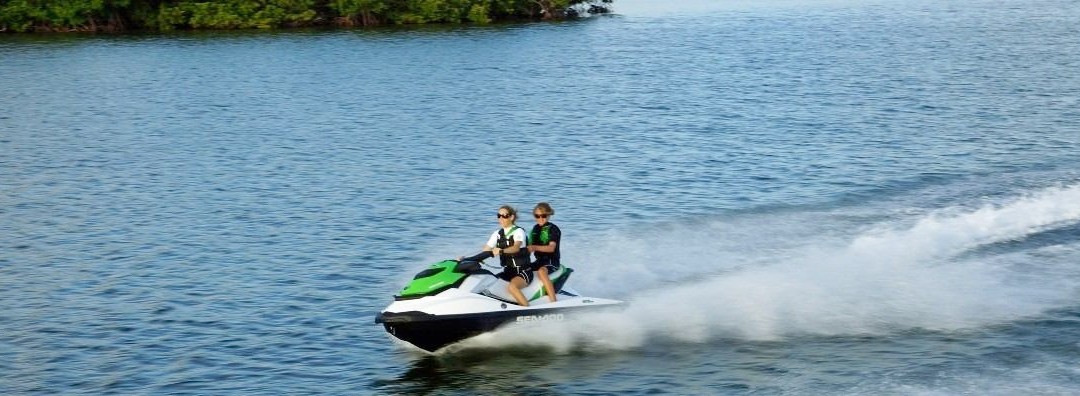
Nov 7, 2017
Remove the Jet Ski Lift from the water
Jet ski lifts need to be removed from the water for the winter in Northern climates to prevent major damage.
Dock-mounted lifts that rotate over the dock should be stored over the dock and secured in case of storms. The Jet ski itself should NEVER be stored on the lift for the winter. Ice accumulations can severely damage the lift. Non-rotating or free standing lifts need to be removed from the water
Jet Ski Lifts- simple yearly Maintenance
Jet ski lifts require simple winterizing maintenance at the end of the boating season in order to prolong it’s life.
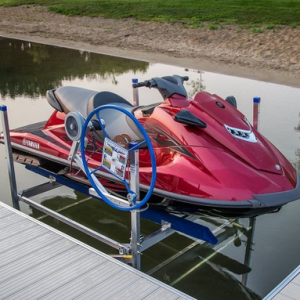
ShoreMaster Cantilever Jet Ski Lift
Here are some things you should do:
- Inspect the jet ski lift at the end of the season for worn parts, frayed cables (extremely important), loose bolts, etc
- For electric powered jet ski lifts, remove the motor and store it inside of a building or relieve the tension on the bungee cords, if so equipped.
- If the water will be freezing during the winter, move the lift to dry land
- Check bearings for noise and proper operation
- Make sure there is no vegetation or sand in the rack frames
- Check all pulleys and other wearable parts for damage. On older models, with plastic pulleys, rotate the pulleys by hand to insure none of the pulley edges are broken. In general, these must be replaced.
- Ensure that the lift moves freely up & down without binding or straining. A general rule when lowering the rack is to maintain downward pressure on the rack.
- For electric jet ski lifts, remove the motor and store it out of the weather or, at a minimum, relieve the tension on the bungee cords, if so equipped.
- All cables should have a quick spray of penetrating oil applied to them, including on the cable wrapped around the winch drum. However, DO NOT APPLY any oil inside the winch mechanism itself.
- Is it time to replace the carpet on the lift bunks or should you consider replacing them with maintenance-free vinyl bunks?
When should I consider these adjustments
Fall or early Spring is a good time to order replacement parts for your jet ski lift. Call or email Pier & Waterfront Solutions for replacement parts. When spring arrives the lift manufacturers have very busy shipping schedules and parts can take longer to get.
Be ready for summer fun.

Enjoy the summer on your jet ski
Sep 12, 2017
Boat Lift Cables Require Maintenance
Boat Lift cables, along with the winch on your lift, are the (2) most important components of a boat lift. As a result, they require periodic attention. Remember, these (2) pieces do all the “work” on your lift. They do the lifting by raising the rack assembly with the weight of the watercraft on it. Lift cables allow your boat, pontoon or PWC to be raised and lowered when you need them.
The lift cables are made of either stainless or galvanized steel.
Both types of steel offer the benefit of corrosion resistance and strength. But there are some noteworthy differences that you need to pay attention to if you are deciding on a new or used lift or just plain replacing the cables.
You need to look at the available options and be able to do simple maintenance on either type of cable. With your owner’s manual, the correct part number, weight capacity, and type of cable should be listed. If it is not listed, or you do not have an owner’s manual, you can contact PWS to get assistance in determining what cables your lift requires regardless of the brand. PWS can get the correct cables so the cables can be replaced correctly.
Types of Steel used as Boat Lift Cables
Galvanized Steel: Galvanized steel is a carbon steel made corrosion resistant by the application of a thin layer of zinc oxide. This is accomplished through a “hot dip” in a zinc bath. The process applies a thin layer or coating of zinc to the steel to increase the metal’s resistance to corrosion.
Galvanized steel is less expensive than stainless steel due to the differences in the processing of each. Galvanized steel is strong and each cable is made to handle the loads created by your boat lift. The downside to galvanized steel is the fact that it has a higher electron-potential than stainless steel, making its’ corrosion resistance less effective because it does NOT regenerate when damaged.
Stainless Steel: Stainless steel is carbon steel which is mixed with about 10% chromium to resist oxidation or corrosion. The chromium in the steel forms a thin layer of chromium oxide that promotes resistance to corrosion. When exposes to oxygen the protective coating WILL regenerate. The anti-corrosion of the chromium simply oxygen to maintain this property of resistance.
Getting technical now
Galvanized steel boat lift cables, although corrosion resistant, are more prone to wear. The zinc layer can be scratched or cracked through expansion and contraction. This can lead to spot rusting and a decreased life of the steel cable. The scratching occurs when a cable rubs against itself as it winds around the winch drum. Each layer is going at a slightly different speed than the layer below it – thus scratching the zinc coating on the cable.
Even internally the strands in the cable are rotating at a different speed and the zinc will be damaged. This can be frequently seen on the upper areas of a galvanized cable where it enters the winch. It also frequently occurs on the bottom layer of a cable where it is wrapped around the drum on the winch.
Stainless steel boat lift cables, on the other hand, are blended with chromium oxide during manufacturing. This makes its corrosion resistance regenerative in fresh water.
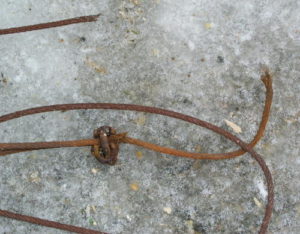
Rusted Boat Lift Cables
You will see lift cable corrosion most commonly in the form of rust.
Galvanized steel cables will corrode over larger areas of its surface while stainless steel cables seldom rust. The addition of chromium to the steel during the production process creates a product that is regenerative and uniform in resistance throughout.
Whereas galvanized steel, with its zinc coating, does not regenerate and when damaged exposes the steel beneath to the elements. The rusted areas are more prone to fraying and breakage too.
In Conclusion … Follow these Maintenance Suggestions for your Boat Lift:
- In spring and fall (and at least once during the summer months), put a short blast or two of PENETRATING OIL on the cables wrapped around the winch drum from the top of the winch. Do not soak the cable, you’ll contaminate the water below. DO NOT use any oil except penetrating oil. NEVER USE GREASE (it traps the moisture inside the cable accelerating it’s deterioration).
- Inspect cables for frays and rust – Caution – wear leather gloves to prevent injury to your hands. Check near the top of the winch cable as this is the most common area for frays. Replace as needed, if corrosion is present.
- Check all cables to make sure they’re aligned properly on the pulleys
- With your watercraft on the rack – check for any slack in the cables. All cables should be equal in tension. Contact PWS for adjustment, if needed.
- Look for cable corrosion near the winch with the rack fully down (but without slack in the lifting cables.)
- If the canopy cover is on, are all the springs or bungee cords secured? Broken hardware should be immediately replaced.
- Check bunks and guides to make sure the hardware is secure.
- If carpeted, replace torn bunk and guide fabrics to protect your boat hull. Consider replacing carpet with vinyl bunks.
- Exterior wheel driven winch? Check the bungee cord to see if it needs replacement. Cracked cords can break at any time so be sure to use the correct cord. Contact PWS for replacements.
- Don’t ignore your dock – check the bolts. Are they secure ?
It is our hope that this article will make your decision easier and lend more confidence to your selection. Your boat lift is an investment and as such we want to make certain that we help you make a wise decision.
Remember
Pier & Waterfront Solutions (PWS) specializes in all ShoreMaster docks, lifts and accessories.
Located in the center of Door County at 7325 St Hwy 57, just south of Sturgeon Bay at the intersection of Idlewild Road. Our staff looks forward to serving all of your waterfront needs.
Found this article helpful? Go to “NEWS” on any page of our website for a complete list of articles meant to keep you informed on the latest product information and maintenance issues. Check out our “older entries” also.
The wide variety of articles on dock and boat lifts issues will answer many of your questions. PWS believes that an informed consumer makes better decisions.
Call Jerry at 920-493-4404 or Email Jerry@wisconsinpws.com for more information.


















